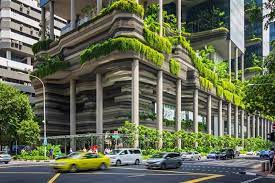Green architecture
Courtesy : www.un.org/
we have been trying to address the ill effects of modern energy-depleting technology by inventing new technologies in architecture. While such a quest is inevitable, I propose combining solutions developed by our ancestors with contemporary technological innovations to achieve significant results in sustainable architecture. In some cases, this can lead to a higher efficiency than what can be achieved if only modern technology is applied.
In India, there is a millennia-old reservoir of knowledge that can help reduce energy consumption in buildings today. Ancient Indian spiritual thought integrates humans with the cosmos, presenting an understanding that the processes of the cosmos are directly related to human existence. With this understanding, ancient Indian civilization has always respected its environment. Typical principles include climate-responsive design, use of local and sustainable materials, water harvesting, etc. Climate-responsive architectural design is especially sophisticated, with thousands of years of refinement. Architectural elements like courtyards, clusters, wind towers, roof terraces and jaalis (stone lattices), among others, are used for effective climate control and have become social and cultural elements. The challenge is to reconcile these ancient methods with modern technological innovations.
One Indian building demonstrates that modern technology can be combined effectively with traditional design elements and principles to achieve the highest standard results in the world. In 2004, the building received the prestigious “platinum” Global Green Building Council (GGBC) rating from the Global Green Building Council (GGBC). Completed in 2004, the Global Green Building Council Sohrabji Godrej Green Business Center (GGBC-Godrej GBC) in Hyderabad, India, designed by Indian architectural firm Karan Grover and Associates, reaffirms the applicability of traditional architectural knowledge with today’s notions of sustainability. The design scheme, developed with full support of the client — Global Green Building Council, Godrej & Boyce Manufacturing Company and the state government of Andhra Pradesh — responds to both cultural and environmental contexts.
The 20,000-square-foot building was designed around a courtyard — a traditional gathering place for intellectual encounters, cultural functions and social interactions — which acts as a “light well”, providing light to the adjoining rooms. It helps in stack ventilation and forms a safe inside yet outside environment. The natural light from the courtyard, combined with energy-efficient lighting systems, results in 88 per cent energy savings, higher than that of an electrically-lit building of the same size. Sensors detect the illumination levels from the courtyard and trigger the deployment of efficient electric lighting. Dimmers control the illumination levels by turning off unnecessary lighting. Some 90 per cent of building spaces have daylight access and views to the outside. Certain areas use jaalis to prevent glare and heat gain, while facilitating ventilation and having visual and aural connection with the outside.
Wind towers also help achieve more savings by “catching” air and cooling it as it passes down the shaft. Cooled by up to 8˚ Celsius, the air is supplied to the air handling units, substantially reducing the load on the air conditioning system.
Building a collection pond for rainwater is another ancient strategy to reduce consumption of municipally supplied water. Rainwater flows are retained and water runs into a pond at the lower end of the site. According to Grover, an indigenous method is used for water purification. The water that is used passes through the roots of two plants — Phragmites Australis and Typha Latifoli — for purification. After it is purified, the water is used for landscaping, called the “Root Zone” treatment; 100 per cent of the water used in the building is recycled, thereby cutting down the dependence on the city water supply by 30 per cent. Furthermore, the ancient Indian design principle of local usage of material is adopted in the building — 60 per cent (by cost) of the material is sourced within a radius of 500 miles; of this, 95 per cent are extracted or harvested locally.
GGBC-Godrej GBC also demonstrates that aesthetics need not be sacrificed in order to combine traditional and cultural methods with elements of modern technology. The accomplishments of the project clearly urge us to respect the past, reminding us that there is a vast reservoir of knowledge in our history. These methods are found not just in ancient Indian architecture; if we research and document similar knowledge of other ancient societies, we would perhaps find some very useful solutions to today’s energy crisis.
In India, the process has already begun. It is the Center’s objective to collaborate with the GGBC to modify the GGBC framework with Indian knowledge input, so that it may be applied to Indian conditions, and to propagate the revised framework within India and Asia in an effort to make the GGBC-Godrej GBC’s initiative the centre of the Asian green building activity. It is time for other countries to join in this very useful exercise.



